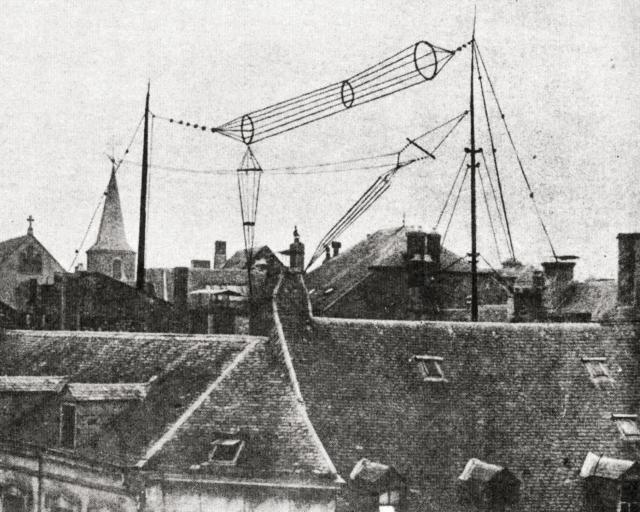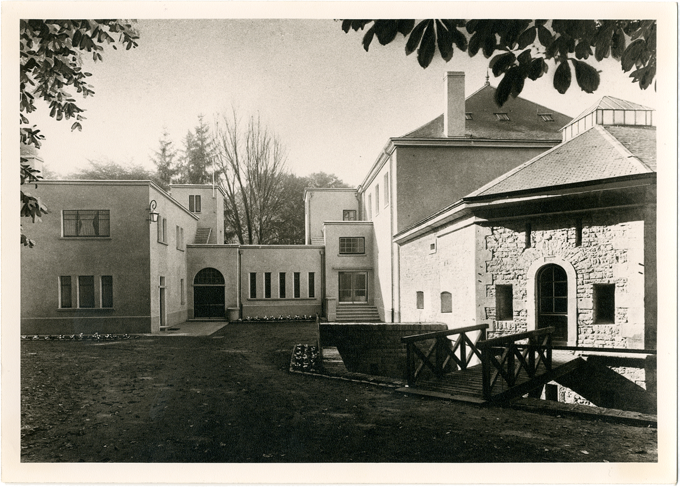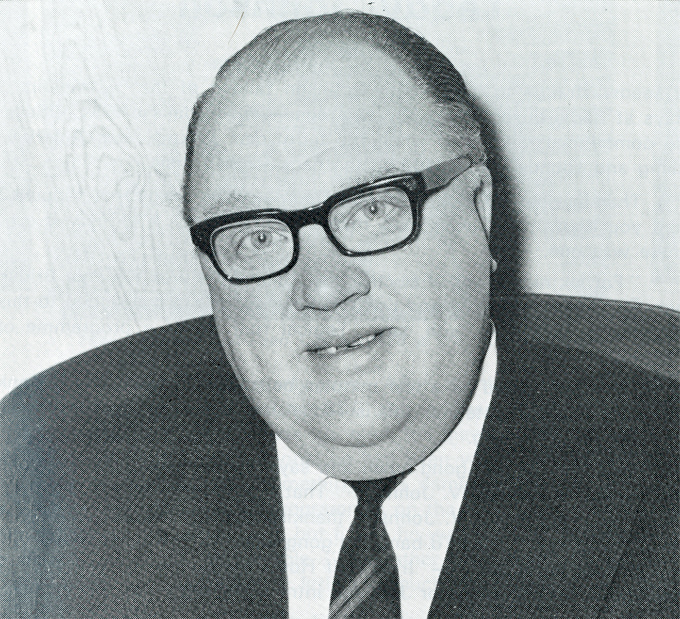With its English language service, Radio Luxembourg was far more than just a radio station. From its long-wave outset in 1933 to its its final shutdown in 1992, Radio Luxembourg was not only the biggest commercial radio station in Europe, it had a formative influence on generations of listeners. ‘The Station of the Stars‘, the famous ‘Two-O-Eight‘, was the expression of freedom and liberty for a whole generation in Western as well as Eastern Europe, and therefore had a major impact on society, especially in the 1950s and 1960s.
It made rock music popular, it was a source of inspiration for many music stars, it was a colourful radio station, a legend!
The 1920s | The 1930s | The 1940s | The 1950s | The 1960s | The 1970s | The 1980s | The 1990s |
The New Century
The 1920s
The world discovers a new method of immediate and far-reaching communication: the radio.
1924
François Anen / Photo Aloyse Anen / ©RTL Group
Enthralled by radio broadcasting, François and Marcel Anen install a radiotelephone transmitter in the attic of their house, 28, rue Beaumont in Luxembourg City, in autumn 1923 and start their first experiments.
In April 1924, the Anen brothers take the step from amateur radio to broadcasting, sending out a regular programme from Luxembourg, playing mainly music records.

Broadcast and receive antenna over the roofs in Rue Beaumont / Photo Aloyse Anen
1925
The house at number 28 Rue Beaumont / Photo Aloyse Anen
The Anen brothers create the Association Radio Luxembourg to run the station.
1926
The station broadcasts records, sports results on Saturdays, and live concerts performed by an orchestra from their attic studio, as well as from outside. The first presenters speak mainly Luxembourgish, but also German, French and English. The transmitter’s power is boosted to 150W.
In France, the Bokanowski decree aims to strengthen the state monopoly in broadcasting. It authorises the existing private commercial radio stations only until 1 January 1933 – by this date they will come under the guardianship of the State. Owners of such radio stations, like Radio Paris and Radio Toulouse, start looking for new opportunities outside France. Some turn towards Luxembourg.

The Orchestra of Radio-Luxembourg
1927
The Association Radio Luxembourg is granted a subsidy by the Luxembourgish State to install a new antenna.
1928
The transmitter’s power is boosted to 250W.
The same year, François Anen accepts the outgoing 3kW transmitter from Radio Toulouse, for use in Luxembourg.
A French–Luxembourgish study syndicate is created, with the aim of installing a powerful radio station in Luxembourg. Named Blue Star Radio, it is represented by the Luxembourgish sports journalist, Alphonse Steinès, and has the financial support of the Banque française et hollando-américaine.
1929
The same aim is pursued by two more companies created in 1929:
On 27 May, the Société Luxembourgeoise d’Études Radiophoniques (SLER), led by the French Compagnie des Compteurs, is officialised.
29 July, sees the officialisation of the Compagnie Nationale de Radiodiffusion Luxembourgeoise (CNRL), led by Jacques Trémoulet, head of Radio Toulouse. The CNRL – in which the Anen station has been integrated, and which was given the frequency of 223m by the Prague Plan in January – starts building a transmitter site in Cessange (Kohlenberg) and begins broadcasting under the name Radio Luxembourg.
François Anen is involved in both companies.
The first Luxembourgish law regulating radio broadcasting is published on 19 December. The law states that any radio station has to be authorised by the head of the Postes et Télégraphes administration.
The 1930s
CLR (Compagnie Luxembourgeoise de Radiodiffusion) is born. The company becomes a European pioneer by broadcasting a unique programme in several languages using the same frequency.
1930
In January the CNRL is ordered by the Luxembourgish authorities to stop broadcasting Radio Luxembourg.
The SLER obtains the exclusive licence for radio broadcasting from the Luxembourg Government. A 25-year concession agreement is signed on 29 September.
1931
The members of the SLER found the Compagnie Luxembourgeoise de Radiodiffusion (CLR). The main shareholders are CSF, Agence Havas (both already associated in Radio Paris), I&P, Banque de Paris et des Pays-Bas, Compagnie des Compteurs, and the Banque Industrielle Belge.
The headquarters of the CLR is established at 53, avenue Monterey in Luxembourg City. François Anen becomes technical head of the new company.
The construction of the transmitter site in Junglinster begins.
Prince Felix of Luxembourg lays the first stone of the transmitter in Junglister / Photo Agence Trampus
1932
The Villa Louvigny / Photo Aloyse Anen / ©RTL Group
Part of the Villa Louvigny – once a 17th century fort located in the heart of Luxembourg City – is rented as headquarters for all radio activities except transmission.
1933
An orchestra is founded under the direction of Henri Pensis. This will become the famous Orchestre Symphonique de Radio Luxembourg.
After an experimental programme, Radio Luxembourg makes its first regular long wave broadcast on 15 March in French and German, from the Villa Louvigny’s studios, using the most modern and powerful (200kW) transmitter in Europe: the site in Junglinster.

Broadcasting centre in Junglinster/ Photo Aloyse Anen / ©RTL Group
On 1 January 1933 Stephen Williams, Directeur-Général of Radio-Publicity, a British company chaired by Frenchman Jacques Gonat, which holds the concession for English programmes at Radio Paris, begins presenting sponsored broadcasts from the French capital. Because commercial broadcasting was prohibited at the time in the UK, sponsored programmes in English were broadcast from the continent (Radio Normandy, Radio Lyons, Radio Toulouse, Poste Parisien, Radio Paris). As Radio Paris was to become a state-run national station, an alternative had to be found for broadcasting English programmes. What better alternative than the most modern and powerful transmitter in Europe?
On Sunday 3 December, English programmes are simultaneously broadcast from Radio Paris and Radio Luxembourg, and finally transferred permanently to Luxembourg the following Sunday.
Stephen Williams at the microphone / Radio Pictorial n°55 / February1, 1935
The international and multilingual programme of Radio Luxembourg is a huge success in Germany, Great Britain, France and Belgium, and astonishes CLR’s competitors.
Concerns are raised especially by the BBC and the British Post Office concerning the power of the transmitter that enables Radio Luxembourg to be broadcast throughout Britain, undermining the BBC’s monopoly. The British authorities also protest vehemently against the wavelength (1250 metres) chosen by the Radio Luxembourg management and which has been denied to the Grand Duchy at the European Broadcasting Conference in Lucerne, claiming it would interfere with British aircraft wireless services. The BBC tries to persuade leading British newspapers not to publish the Radio Luxembourg schedules.
1934
In February, Radio Luxembourg switches to a new wavelength of 1304 metres, which had been allocated to Warsaw by the Lucerne Wavelength Plan. This is regarded as illegal by the International Broadcasting Union who has however no coercive power. English programmes from Luxembourg enjoy growing popularity among British listeners, especially as the Sunday broadcasts on the BBC are rather austere in accordance with the Sunday Observance restrictions, whereas Radio Luxembourg broadcasts jazz and light music.
Christopher Stone joins the commercial station Radio Luxembourg in September. This sensational move is considered an act of lèse-majesté by the prim BBC, who consequently blacklists him as well as other British artists who work with Radio Luxembourg.
Christopher Stone / Radio Pictorial September 28, 1934
Christopher Stone and Stephen Williams in the studio at Villa Louvigny / Photo Aloyse Anen / ©RTL Group
1936
A legal battle between the CLR and Radio Publicity (London), the English language concession company, leads to the revocation of the concession in favour of the newly created Wireless Publicity Ltd, which is actually a subsidiary of the ostensibly private firm Cable & Wireless Ltd, whose vast undersea cable network was the subject of considerable British government interest and secret subsidies.
Under the impulse of this new agent, Radio Luxembourg expanses with daily programmes in English and asserts its dominance until 1939.
1937
Following the ongoing success of Radio Luxembourg, CLR buys the Villa Louvigny and extends the premises.
1938
From May 1938 to September 1939 a De Havilland Dragon airplane christened ‘The Luxembourg Listener’ (Olley Air Service) makes a twice weekly return trip from Croydon to Esch-sur-Alzette carrying taped programmes, records and passengers.
The ‘Luxembourg Listener’ / Radio Pictorial n°231 / June 17, 1938
In Britain audience figures peak at around four million.
1939
On the eve of war, the Luxembourg government, concerned about maintaining Luxembourg’s neutrality, asks CLR to stop broadcasting – a decision already considered by the company’s management. Regular programmes cease on 2 September, and broadcasting is limited to official government communiques and music. Less than three weeks later, on 21 September, operations are closed down.
![]()
The 1940s
War time. The government demands that CLR suspends its activities and, from 1944 onwards, the Allies use the radio station. Radio Luxembourg begins broadcasting again in November 1945.
1940
Nazi soldiers at the entrance of the Radio Luxembourg studios / Taken from the German propaganda book ‘Moselland : ein Bildbericht’ by Frid Muth and Herbert Ahrens
On the day of the Nazi invasion, Radio Luxembourg installations are among the first objectives of the Wehrmacht in the Grand Duchy. Four weeks later, German troops restart the station, using it for their communication until October 1940, when the transmitter is incorporated into the Reichs-Rundfunk-Gesellschaft and used for Nazi propaganda.
Radio Luxembourg is used as a relay station by German stations such as Radio Hamburg to broadcast Nazi propaganda to Britain from 1940-1945 by Irishman William Joyce, better known as Lord Haw-Haw.
1944
US soldiers at the Radio Luxembourg studios / From the movie ‘Allied soldiers use Radio Luxembourg during WWII’
American troops come to liberate the country. After an agreement between the Luxembourgish Government in exile and the United States, the transmitter, which has been damaged by the German army, is made available to the Psychological Warfare Division (PWD) of SHAEF (Supreme Headquarters Allied Expeditionary Forces). The PWD was an Anglo-American organisation that used radio broadcasting to undermine German soldiers’ morale.
1945
The Office of War Information begins to use the station in July, handing over the installations to the CLR on 11 November.
Radio Luxembourg begins broadcasting again on 12 November 1945, with the famous words: “Bonjour le Monde, ici Radio Luxembourg.”
1946
Stephen Williams returns to Radio Luxembourg on 7 January as Director of English programmes. English-sponsored programmes start 1 July 1946.
1947
Radio Luxembourg Advertising Ltd is founded. CLR holds a 75% stake, and Information & Publicity (IP) the remaining 25%. Major General W. H Grey chairs the company, which has its headquarters at 154 Strand, London.
1948

Offices are leased at 34 & 36 Davies Street, and at 25 Brooks Mews, London.
At the Copenhagen European Broadcasting Conference, Radio Luxembourg obtains the right to broadcast on 208 metres medium wave.
![]()
The 1950s
The use of a medium wave transmitter contributes to the spectacular development of the CLR’s radio business.
1951
Inauguration of the medium wave transmitter in Junglingster in the presence of Grande Duchesse Charlotte and Prince Félix / RTL Group archives / ©RTL Group
CLR’s new medium wave transmitter in Junglinster is inaugurated.
Radio Luxembourg transfers its English programme to medium wave 208. ‘Two-O-eight’ becomes a new reference for young Britons. Part of the broadcasting on medium wave is also occupied by a programme in Dutch and Luxembourgish. The success of Radio Luxembourg grows day by day.
CLR Limited is established.
1952
38 Hertford Street / Taken from Radio Télé Luxembourg – Au carrefour de l’Europe
Studios and offices are established at 38 Hertford Street, London.
1953
Logo with the winged lion / RTL Group archives
The ‘new’ Villa Louvigny is inaugurated in Luxembourg City. The winged lion with the motto ‘Alas Leoni dedit’ (‘It gave wings to the lion’) decorates the front of the building.
1954
Radio Luxembourg Advertising Ltd is taken over by CLR London Ltd.
The management of CLR enters into a new era of broadcasting: television. On 1 July, CLR becomes CLT (Compagnie Luxembourgeoise de Télédiffusion) and begins the construction of a TV transmitter and studio in Dudelange.

TV Broadcasting centre in Dudelange / RTL Group archives
1955
On 22 September, the commercial TV channel ITV starts broadcasting from London. This affects Radio Luxembourg as a number of its sponsored programmes move to ITV. Sponsorship now switches mainly to record companies such as Decca and EMI.
1956
Medium wave transmitter in Marnach / Taken from ‘The Station of the Stars’ 1965
The 350kW medium wave transmitter – relocated from Junglinster to Marnach to provide a better reception in England and Scandinavia – goes into service.
![]()
The 1960s
1964
Radio Caroline, the first of several British pirate offshore radio stations, starts broadcasting from a ship. These pirate stations, broadcasting mainly rock and pop music, are major competitors to Radio Luxembourg.
1966
In June, Radio Luxembourg 208 and the magazine Fabulous link up. The magazine Fabulous 208 is born.
1967
The Marine Broadcasting Offences Act outlaws pirate offshore stations, although some unlicensed radio stations continue broadcasting. To counter the popularity of these illegal broadcasters and the ongoing success of Radio Luxembourg, the BBC is restructured, establishing Radio 1, Radio 2, Radio 3 and Radio 4.
1968
Radio Luxembourg 208 changes its format, shifting from sponsored pre-recorded programmes to an all-live format with commercial breaks.
![]()
The 1970s
1970
Geoffrey Everitt / Radio Luxembourg 1979
After 25 years at Radio Luxembourg, General Manager Geoffrey Everitt leaves the station and is succeeded by Alan Keen. Under his management, the Radio Luxembourg Roadshows were conceived during which the station’s DJs toured the UK.
1972

The transmitter in Beidweiler / RTL Group archives
Powerful long-wave transmitters go into service at the Beidweiler site. The Junglinster transmitters are used as back-up.
1973
Licences for independent local commercial radio stations are awarded by the British broadcasting authorities.
![]()
The 1980s
1980
Alan Keen leaves Radio Luxembourg after 10 years at the station and is succeeded as General Manager by Patrick Cox.
1989
On 1 September, Atlantic 252, an English-language radio station, is launched in Ireland by Radio Tara as a joint venture between the Irish state broadcaster RTÉ and CLT. The station broadcasts from Trim in the Republic of Ireland.
![]()
The 1990s
CLT continues to expand into new countries, setting up a complementary network of TV channels and radio stations and thus beginning to create families of channels. At the end of the nineties, the merger of CLT and UFA creates the leading European broadcaster and production house, and is a turning point in CLT’s history: CLT-UFA is the European Entertainment Enterprise.
1990
Radio Luxembourg London (RLL) moves its offices from 38 Hertford Street to 74 Newman Street.
John N. Catlett becomes General Manager of the station.
In August, RTL International is launched. Aimed at Scandinavian audiences, it offers a daytime schedule broadcasting on the Astra 1A satellite using a 24-hour stereo transponder.
1991

The KB1 building in Kirchberg / RTL Group archives
The new building at Kirchberg is inaugurated: it will become the Group’s administrative and radio headquarters. TV activities remain in the now legendary Villa Louvigny.
Radio Luxembourg, the medium wave programme that contributed to the reputation of CLT in Europe – particularly the UK – for many decades, stops broadcasting on 30 December 1991.
1992
The satellite and short-wave service is dissolved after exactly one year, at midnight on 30 December 1992.
1993
CLT SA acquires the office building at 74 Newman Street.
![]()
The New century
2001
In October RTL Group sells its 80% share in Atlantic 252 to Teamtalk.
2005
The Legend Is Back! RTL Group is using the new DRM (Digital Radio Mondiale)technology to re-launch Radio Luxembourg in English on several short wave frequencies, notably 7145 KHz, offering a format of Classic Rock.
Radio Luxembourg can also be heard as a live stream over the Internet.




















